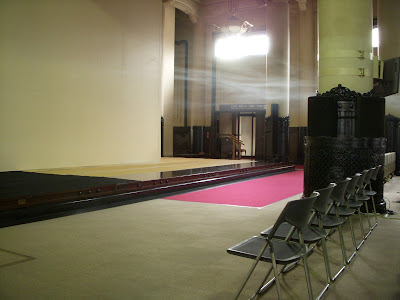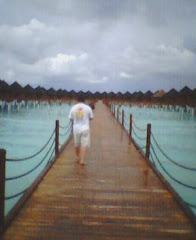After getting my fill of fish, fish, and more fish at the Tsukiji Central Wholesale Market, it was time to move away from the seafood motif. However, before heading home I saw a sign pointing to another temple that I haven't been to - the Tsukiji Hongaji Temple (it's written as Hongwanji Temple on their English language pamphlet). This temple seems to be built more like a church than your typical Japanese temple. Fortunately, it didn't give off the creepy vibes like that other place I visited near Shinagawa - the Tokyo Shoshinkan.
築地市場を探索したあと、そろそろ帰るモードに入ったが、最初に築地に降りた時気になってたお寺も発見。帰る前そのお寺も覗いてみようと思いました。お寺なのに、造りがまるで外国風の教会な感じがする。結構広い。これ本当にお寺と思うくらい。良かったことに以前品川で怪しげな建物(東京正心館)の雰囲気はありませんでした。
Lets take a peak inside.
中をちょっと覗いてみよう。
Here is a short history of Tsukiji Honganji Temple taken from the English language pamphlet:
The Tsukiji Hongwanji Temple is a Betsuin (branch temple) of the Jodo Shinshu Hongwanji-ha denomination, of which the Mother Temple, or Honzan, is located in Kyoto. Due to its geographic location within Kyoto, the denomination is commonly known as Nishi (west) Hongwanji.
The history of this temple dates back to the year 1617 when Junnyo Shonin, the 12th hierarchical leader, or monshu, of the Hongwanji, established a temple at Yokoyama-cho near Asakusa in Edo (olden day Tokyo). Known in those days as the Edo-Asakusa Gobo, the temple went up in flames in the Great Fire of 1657. Unfortunately, permission to rebuild on the original site was denied by the Bakufu (feudal government), as it did not fit in with reconstruction plans for the area. In exchange, the Betsuin was allocated a parcel of land off the shoreline of Hatchobori, which had to be reclaimed from the sea. This land reclamation and reconstruction project was undertaken by countless devout followers, mainly living on nearby Tsukudajima. The word Tsukiji literally means "built up land," indicating that this district was reclaimed land. When the Main Worship Hall, or Hondo, was built on this land, the temple came to be called Tsukiji Gobo. The district around the the temple is called Tsukiji due to the historical background.
That temple was lost in the Great Kanto Earthquake of 1923, and the present temple that replaced it, with its Indian architectural motif, was designed by Itoh Chuta. Professor of the Faculty of Architecture at Tokyo University. The construction began in the year 1931 and was completed in 1934, displaying the fervent devotion of the Shinshu followers.
日本人の読者は築地本願寺のウェブサイトをチェックして下さい:
http://tsukijihongwanji.jp/tsukijihongwanji/982
Details also available in English at:
http://www.tsukijihongwanji.jp/tsukiji/index_e.html
I didn't realize this was the same temple where the wake was held for former X-Japan guitarist Hide who had committed suicide until I came upon a memorial to him inside the main hall. I remember the news from 1998 when 20,000 to 50,000 fans attended the services.
中に入って分かったけど、X-JapanのHideの追悼式がここで行われてた。1998年のニュースは覚えてる。2万から5万人のファンが集まって大変な事になった。
Memorial to Hide of X-Japan
Floral Hide
As the temple ground covers a huge area I did a little exploring and discovered a few more pieces of history. The graves of four prominent people (at least I think so since all four had signs giving us information on who they were and what they did).
お寺の周辺も歩き回ると、また日本歴史に関するものいろいろ発見しました。 有名かどうか分かりませんが、4人のお墓がありました。その4人のお墓は東京文化財にも登録されてます。
The grave of Habu Genseki / 土生玄碩墓 (はぶげんせきはか)
Thank goodness for the internet or I would only have had a vague idea of who this was. 「Habu Genseki (1762-1848) was originally from Yoshida in the Akino province and practiced Dutch medicine at the end of the Edo period. He was the shogun’s personal doctor and his expertise was in ophthalmology. He later learned how to heal eye disease from the German doctor Siebold who worked for a Dutch trading house. He gave Siebold the coat of arms of the Tokugawa clan as a farewell gift, which he had been given earlier from the Shogun. He was implicated in what became the Siebold Affair because of this.」
Hazama Shinroku Memorial (one of the 47 Ronin)
「Shinroku was one of the 47 Ronins. On his way back from the Kira mansion in Honjo Matsuzaka-cho to Takanawa Sengakuji Temple after fulfilling a task (the murder of Kira Kozukenosuke as his contribution to the welfare of the other 46 Ronins), he threw 50 ryo (a unit of money) bundled to a hand spear into the premises of Honganji Temple. This was the payment for his own funeral rites. He was then held captive at the mansion of Mori Kai no Kami of the Chofu clan and on 4th February 1703 he died by committing harakiri. He was 24 years old.」
The grave of Mori Magoemon (actually a part of it, I didn't realize that the sign referred to two pillars, this was the one on the left) / 森孫右衛門供養塔 (気が付きませんでしたが、右側の塔の写真を撮ってない)
「The grave of the founder of Tsukudajima is at Tsukiji Hongan Temple, but it is a reconstructed grave erected by his descendants for his 200th memorial year. Starting on the left hand side, the record of the relationship between Tsudajima folk and the Tokugawa clan is engraved on the back of the gravestone. It is treasured as a valuable gravestone relating the history of Tsukudajima.」
The grave of Sakai Hoitsu / 酒井抱一墓 (さかいほういつはか)
「Sakai Hoitsu (1761-1828) was an artist in the last days of the Edo period and was also known as Oson or Ugean. Hoitsu became a Buddhist priest in Nishi Honganji Temple and received the name Gon no Daisozu, but lived an elegant life in seclusion in Edo. He was talented both in painting and poetry. He followed the painting style of Ogata Korin, which added even more sophistication to his pictures, and led to the foundation of a new school of painting. His grave is at the Tsukiji Honganji Temple.」
Monument to Kujo Takeko / 九条武子記念碑
「A monument to the Kyoto-born poet Kujo Takeko (1887-1928) stands in the precinct of the Tsukiji Honganji Temple. One of her poems is written on this monument and translates as follows: “When being pulled by a greater cause, my own footprints seem so unsteady”. Takeko was the second daughter of the head of Nishi Honganji Temple, Otani Koson, and was the wife of Kujo Yoshitomo. Her main anthologies are “Kinrei (Golden Bell)” and “Kunzen”, while her most famous essay is “Muyuge”.」
The above is written on the monument but it is quite difficult to make out.
Shinran Shonin, founder of Jodo Shinshu Buddhism / 親鸞聖人
There is also a monument to victims of accidents / 陸上交通殉難者追悼之碑
One final look at Tsukiji Honganji Temple
もう一回築地本願寺を眺める。
But wait, I didn't go home after checking out the Tsukiji Hongaji Temple. I continued my walk around Tsukiji and found a few more interesting places and items of interest.
築地本願寺を探索したあと、帰りませんでした。築地の散歩がまだまだ続いてました。そしてまた面白い記念碑なども発見。それはまた今度。






















.jpg)



No comments:
Post a Comment